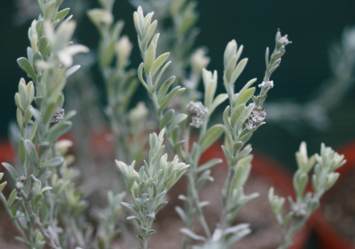Petalacte coronata
Petalacte coronata (L.) D.Don
Family: Asteraceae
Common names: paper flower (Eng.); wildesewejaartjie (Afr.)
Introduction
Petalacte coronata produces white flower heads in clusters from June to November. The distribution of the plant seems to influence the length of flowering. The grey leaves create an attractive contrast when planted amongst other colourful plants.

Description
Description
Petalacte coronata is a dense, shrublet which forms clumps and can reach a height of 500mm.. Stems and the elliptical leaves are covered with white-woolly hairs. The narrow grey leaves seem to point upward and are alternately arranged, overlapping each other.

The flower heads appear in clusters at the tips of the stems. The flower bracts are white and have a papery feel hence the common name.
Conservation Status
Status
This plant enjoys a non-threatened or LC (Least Concerned) status; it appears quite frequent in its natural habitat.
Distribution and habitat
Distribution description
Petalacte coronata is found on coastal dunes and sandstone slopes, and includes areas such as Clanwilliam to Bredasdorp in the southwestern Cape.
There is only one species in the genus and it is endemic to the Western Cape.
Derivation of name and historical aspects
History
Petalacte coronata is derived from two Greek words and one Latin word and refers to the arrangement of the bracts that looks like florets; petalon (Greek) refers to a ‘petal' and aktis (Greek) refers to a ray. The specific epithon coronatus (Latin) refers to ‘crowned'.
Ecology
Ecology
Insects are responsible for the pollination of this plant.
Uses
Use
The plant is long-flowering and can be successfully used in the borders of garden plant beds and it also complements other low-growing plants when planted amongst them. It makes an ideal pot plant.

Growing Petalacte coronata
Grow
Planting in garden beds
This plant will grow happily in a garden spot provided it receives sunlight for the larger part of the day; the soil must be well drained in order to prevent overwatering and conditions for soil-borne diseases which can adversely affect the growth of the plant.
Container planting
Petalacte coronata is hardy and grows in warm areas; it is also ideal to be grown in pots given its low compact growth habit provided that the container drains well. If you need to feed the plant, rather use a slow-release granular or liquid fertilizer.
Propagation
Plants can be easily propagated from cuttings, provided the cuttings are made after the flowering season (March/April). Make the length of the cuttings about 70 – 80 mm. Use a semi-hardwood hormone powder to dip the cuttings in — this will help to encourage root development. Use the following mix to grow your cuttings: fine milled bark (50%) + polystyrene (50%); you may also use perlite as a substitute for polystyrene. Place the cuttings in a warm, sheltered area; roots start to develop after a period of 4 weeks. Pot the cuttings by making up a mixture of 70% fine bark and 30% coarse river sand.
Pests/disease
Aphids can be successfully controlled by spraying with an organic pesticide. Ensure that the plant does not grow too large for the container as this will lead to root congestion.
References
- Burman, l. & Bean, A. 1985. Hottentots Hollands to Hermanus . Wild Flower Guide 5. Botanical Society of South Africa, Cape Town.
- Goldblatt, P. & Manning, J. 2000. Cape Plants. A conspectus of the Cape flora of South Africa. Strelitzia 9. National Botanical Institute, Pretoria & Missouri Botanical Garden, Missouri.
- Jackson, W.P.U. 1990. Origins and meanings of names of South African plant genera. University of Cape Town.
- Manning, J. 2007. Field guide to Fynbos. Struik Publishers, Cape Town.
- Smith, C.A. 1966. Common names of South African plants. Memoirs of the Botanical Survey of South Africa No. 35. Government Printer, Pretoria.
- Trinder-Smith, T.H. 2003. Guide to the plant genera of the southwestern Cape . Paarl Print, Paarl.
- Trinder-Smith, T.H. 2006. Wild flowers of the Table Mountain National Park. Associated Printing, ??? .
Credits
Benjamin Festus
Harold Porter National Botanical Garden
November 2014
Plant Attributes:
Plant Type: Perennial, Shrub
SA Distribution: Western Cape
Soil type: Sandy
Flowering season: Spring, Early Summer, Winter
PH: Acid
Flower colour: White
Aspect: Full Sun
Gardening skill: Average
Special Features:
Horticultural zones







Rate this article
Article well written and informative
Rate this plant
Is this an interesting plant?
Login to add your Comment
Back to topNot registered yet? Click here to register.